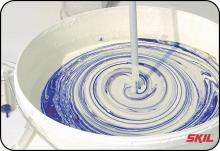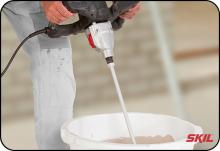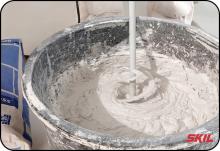-
What are the different paddles for?
When choosing a mixing paddle, you need to think about the connection. Round and six-sided (hexagonal) connections are suitable for use on a hammer drill, whereas an M14 connection only fits a paddle mixer. Another important factor is the direction of the mixing flow. You can get paddles that move downwards to minimize lump forming. These are ideal for mixing liquid and semi-liquid materials. Paddles that move upward are designed to mix dense and semi-liquid materials with minimum resistance. You can also get paddles that move sideways. These move powerfully, minimizing spatters. They can be used to mix liquids and semi-liquids.
Various types of mixing paddle are available for mixers and hammer drills. These are among the most common ones.
-
1) Paddle for liquids
Paint, lacquer, primer, putty and thin plasterwork are classed as liquids. When mixing these, use a paddle designed for liquid materials. -
2) Paddle for semi-liquids
Mortar, thinset and tile adhesive are examples of materials that can be mixed with a paddle designed for semi-liquid materials. -
3) Paddle for dense materials
A paddle for dense materials is recommended when mixing cement, plaster, tile adhesive and mortar.


